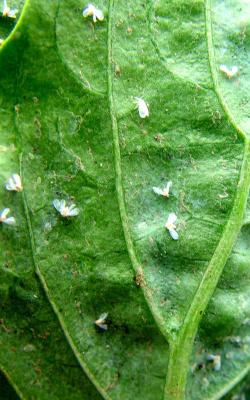


Tobacco whitefly (Bemisia tabaci)
Tobacco whitefly is a serious pest of tomatoes. Whiteflies attack tomatoes from seedling to mature stage. They suck sap from the leaves, and may weaken the plants. Feeding of whiteflies cause yellowing of infested leaves. Immature stages (nymphs) produce honeydew on which sooty mould grows. Heavy honeydew or mould coating reduces plant growth and fruit quality.
The main damage caused by whiteflies is indirect as vectors of virus diseases. Bemisia tabaci transmits several virus diseases in tomato. In particular it is an efficient vector of the Tomato Yellow Leaf Curl Virus (TYLCV), a major disease in Kenya.
Small numbers of whiteflies do not cause major direct plant damage. However, even small numbers of whiteflies may need to be controlled in areas where TYLCV is common.
- Time sowing and transplanting. If possible avoid the season when whiteflies are more likely to occur.
- Use cover crops (forage, peanut, weeds) and inert covers (silver, yellow, and white/black plastic mulches). They have been shown to reduce whitefly damage in tomatoes. Whiteflies are attracted by the colour of the plastic mulch. The heat of the plastic kills the whiteflies. However, this is effective as long as the plants are young and do not cover the mulch. The protection can last for 10 to 20 days after transplanting and about 30 days after direct seeding. Take care to avoid sunscald when using plastic covers.
- Prevent physical contact of the whiteflies with the plant; this can prevent the transmission of viral diseases. Cover tomato seedling nurseries with nylon nets or use tunnels for 3 to 5 weeks to protect seedlings from whiteflies infestation. These methods have been reported to reduce the transmission of the Tomato Yellow Leaf Curl Virus in several countries.
- Conserve natural enemies. Whiteflies are mainly attacked by parasitic wasps and by predators such as phytoseiid mites, lacewings and ladybird beetles. For more information on Natural enemies click here
- Check the crop regularly. Use yellow sticky traps to monitor the presence of whitefly adults. Yellow traps are also an effective control method of whitefly at low infestations. For more information on Traps click here
- Remove weeds in advance of planting tomatoes, and keep tomato fields weed-free. Weeds play an important role in harbouring whiteflies between crop plantings. They also often harbour whitefly-transmitted viruses.
- If necessary spray neem extracts. Neem-based insecticides are reported to substantially reduce egg laying by B. tabaci, inhibit the growth and development of nymphs, and significantly reduce the risk of TYLCV transmission.
- Spraying with soap and water solutions reportedly controls whiteflies. The amount of soap needed depends upon the soap type. For more information on Soap spray click here
- Plant barrier crops. Fenugreek and coriander are reported to repel whiteflies.
